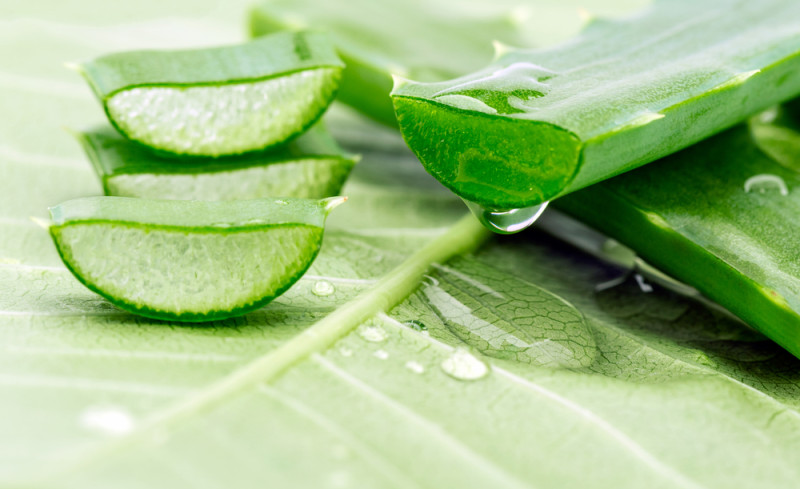
Every kitchen should have one or two potted aloe vera plants on the windowsill. The plant has been used medicinally since prehistoric times. Today the clear jelly inside aloe vera leaves is a popular herbal remedy for sunburn, minor wounds, and other skin problems. It has even been used to treat haemorrhoids and insect bites because it is rich in anti-inflammatory agents and the gel forms a cool, soothing coating on itchy, irritated tissues.
What’s it good for?
- acne
- age sports
- athlete’s foot
- blisters
- dry hair
- dry skin
- heat rash
- psoriasis
- shaving rash
- shingles
- sunburn
- warts
- wrinkles
Researchers are studying aloe vera for its potential benefits when taken orally, but so far have reached no definite conclusions. However aloe vera enthusiasts are convinced that the gel – or a juice containing a high concentration of aloe vera – can be taken by mouth as a treatment for arthritis, diabetes and peptic ulcers. It is probably wise to take such claims with a large pinch of salt, but one thing that is known is that aloe vera is one of the best natural skin remedies ever discovered.
Powerful skin healer
Scientists are not exactly sure how aloe vera works, but they have identified many of its active components. The gel contains gummy substances that from soothing natural emollients. It is rich in anti-inflammatory compounds as well as a chemical called bradykininase that acts as a topical painkiller. The magnesium lactate in aloe vera soothes itching and the gel contains substances that promote healing by dilating blood vessels and increasing blood flow to injured areas.
Aloe vera is helpful for a variety of skin conditions, including:
- Minor burns A quick application of aloe vera gel reduces pain, moistens the skin and keeps germs and air out. It soothes the pain of sunburn as well. To relieve the pain of widespread sunburn, add a cup or two of aloe vera juice to a bath of luke-warm water and have a cooling soak.
- Cuts and Grazes Aloe vera gel dries to form a natural bandage over skin and speed up healing. However, it’s not a good choice for serious wounds. Researchers at a Los Angeles hospital found that the gel actually increased the time it took such wounds to heal.
- Psoriasis The gel soothes inflammation and softens the itchy skin scales that characterize this chronic skin condition. One four-week study found an 83 per cent rate of skin clearing in those who used aloe vera compared to only 6 per cent of those using an inactive cream.
- Acne Apply aloe vera when you have a painful outbreak. One study found that 90 per cent of skin sores completely healed within five days using aloe vera – nearly twice the success rate of those applying conventional acne medications.
- Shingles Painful lesions caused by the herpes virus heal more quickly when aloe vera is applied to the skin. The gel appears to have some antiviral effects. In addition, aloe vera dilates tiny blood vessels known as capillaries, allowing more blood to reach the area so speeding up healing.
The inside story
Doctors are unanimous that aloe vera gel is helpful for minor skin ailments, but when about taking the gel or juice by mouth? Nothing has been proved yet but a number of studies suggest some intriguing possibilities. For example, a scientific study found that volunteers who took aloe vera juice twice a day for up to 42 days had significant reductions in blood sugar, suggesting that it’s potentially helpful for treating diabetes.Japanese researchers report that the active ingredients in aloe vera inhibit stomach secretions and sores, giving credence to aloe vera’s reputation as an ulcer remedy. In fact, two of the active chemical compounds in aloe vera appear to inhibitor destroy Helicobacter pylory, the bacterium that causes most ulcers.
Finally, a chemical compound called acemannan, found in the outer skin of aloe vera, may have antiviral activity. But much more work must be done before scientists are able to determine its usefulness.
Too strong for comfort
Aloe is a very effective – too effective, really – laxative. Aloe latex, which is extracted from the leaf’s rind, is classified as a stimulant laxative. It stimulates intestinal contractions that promote bowel movements. As with other stimulant laxatives, however doctors rarely recommend it. It can cause severe cramping or diarrhea, along with loss of fluids and vital electrolytes – minerals that play critical roles in the body.
How to use Aloe vera
You can buy skincare products containing aloe vera from supermarkets and pharmacies, but it isn’t clear whether the ‘stabilized’ form of aloe vera in these products has the same beneficial effects as the natural gel. If you do buy prepared creams or lotions, make sure that aloe vera appears near the top of the ingredients list. For internal use, buy juices that contain at least 98 per cent aloe vera.
To get the full benefits of aloe vera, there’s no substitute for the real thing. The plant is easy to grow – even for the most inexperienced and least greenfingered gardener. It thrives on neglect, needing little water and tolerating shade and poor soil. However, aloe vera should not be exposed to temperatures below 50C and is therefore best suited to growing on windowsills or in greenhouses.
To soothe sunburn, cuts, piles and minor burns, wash the area thoroughly with soap and water. Then cut a chunk off a large leaf, slice it lengthwise and squeeze out the gel. Apply a generous coating to the injured area and repeat the treatment two or three times a day.